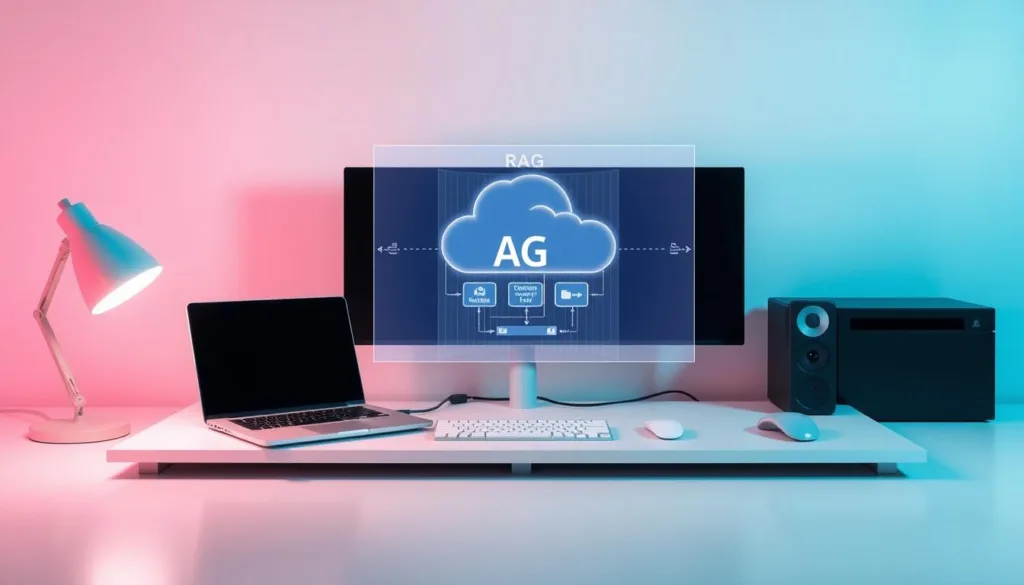Using a cost-effective RAG model on Google Cloud Platform can change the game for businesses. It’s perfect for those wanting to use machine learning. This model is great for tasks like understanding language and seeing images.

Google Cloud Platform has many tools for managing RAG models. It’s a top pick for businesses and developers. Its cost and scalability make it ideal for machine learning. Starting with a RAG model on Google Cloud can benefit many industries, from healthcare to finance.
Introduction to Cost-effective RAG Model Deployment
The cost-effective RAG model is a powerful tool for businesses. Deploying it on Google Cloud Platform can make operations smoother and more efficient. It helps businesses stay ahead in the market.
Key Takeaways
- Cost-effective RAG model deployment on Google Cloud Platform offers scalability and reliability
- Google Cloud Platform provides a range of tools and services for machine learning and artificial intelligence applications
- The cost-effective RAG model can be used for various tasks, including natural language processing and computer vision
- Deploying a cost-effective RAG model on Google Cloud Platform can help businesses to streamline their operations and improve efficiency
- Cost-effective RAG model deployment on Google Cloud Platform is a cost-effective solution for businesses looking to implement machine learning and artificial intelligence applications
- Google Cloud Platform is a popular choice among businesses and developers for machine learning and artificial intelligence applications
Understanding RAG Models and Their Business Value
cost-effective RAG model on Google Cloud Platform -The RAG model uses artificial intelligence to boost business value. It helps organizations gain new insights and make better decisions. It’s great for tasks like understanding complex data through natural language processing and computer vision.
One big plus of the RAG model is how it improves accuracy and efficiency. It automates tasks and offers predictive analytics. This helps organizations run smoother and save money. It also enhances decision-making by giving valuable insights.
Here are some ways the RAG model is used in real life:
- Sentiment analysis: It helps analyze customer feedback, giving insights into what customers want and like.
- Image classification: It classifies and analyzes images, making tasks like image recognition and object detection easier.
- Recommender systems: It builds systems that suggest personalized products, enhancing the customer experience and boosting sales.
In summary, the RAG model is a powerful tool for businesses. It uses artificial intelligence and machine learning to unlock new insights and improve decision-making. This leads to growth and success for organizations.
Prerequisites for GCP RAG Model Deployment
To deploy a RAG model on Google Cloud Platform, you need a few things. First, you must have a GCP account. You also need a machine learning framework like TensorFlow or PyTorch. Plus, you’ll need a dataset to train the model. Cloud computing resources are key for a successful deployment.
Before you start, make sure your GCP account is ready. You need the right permissions and credentials. This includes setting up billing and payment info, and configuring security settings. Here are the main things you need for GCP RAG model deployment:
- Google Cloud Platform account
- Machine learning framework (e.g., TensorFlow or PyTorch)
- Dataset for model training
- Necessary permissions and credentials
cost-effective RAG model on Google Cloud Platform -Meeting these requirements helps ensure a smooth deployment. You’ll get to use the power of cloud computing and Google Cloud Platform.
Architecture Overview for Cost-effective RAG Model Deployment on Google Cloud Platform
Deploying RAG models on Google Cloud Platform needs a solid architecture plan. This plan should focus on making the deployment cost-effective. It should also ensure the system is scalable and reliable.
Choosing the right components, like virtual machines and storage, is key. The infrastructure should be able to grow or shrink as needed. This flexibility helps keep costs down. cost-effective RAG model on Google Cloud Platform
When designing the architecture, think about the trade-offs. For example, preemptible virtual machines save money but might restart more often. This could impact the system’s scalability.
- Match resource sizes to your workload needs.
- Use autoscaling to adjust resources as needed.
- Keep an eye on costs with cost monitoring and optimization tools.
By following these tips and understanding RAG model deployment needs, you can create a cost-effective architecture. This architecture will balance scalability, reliability, and cost on Google Cloud Platform.
Setting Up Your GCP Environment
To deploy a RAG model on Google Cloud Platform, you need to set up a GCP environment. This involves creating a GCP account, setting up a project, and enabling the necessary APIs. Start by going to the GCP website and signing up. After creating your account, set up a new project and enable the required APIs.
In a GCP environment, cloud computing resources are used to deploy and manage applications. To set up your GCP environment, you will need to create a storage bucket to store your dataset and trained model. Here’s how to do it:
- Log in to your GCP account
- Navigate to the storage section
- Click on “Create bucket”
- Follow the prompts to set up your bucket
Setting up your GCP environment is a crucial step in deploying your RAG model. By following these steps, you can ensure that your environment is properly configured and ready for deployment. cost-effective RAG model on Google Cloud Platform
Data Preparation and Storage Optimization
When you use a RAG model on Google Cloud Platform, data preparation is key. It means cleaning, transforming, and formatting your data for the model. This makes sure your data is right, complete, and consistent. It’s vital for the best results. cost-effective RAG model on Google Cloud Platform
Choosing the right storage is also important. You can use GCP storage buckets or BigQuery for your data and model. Storage optimization cuts costs and keeps your data ready for use. The right choice helps save money and boosts efficiency.
- Using automated data processing tools to reduce manual errors and increase efficiency
- Implementing data compression and encryption to reduce storage costs and ensure data security
- Utilizing cloud-based storage solutions that offer scalable and flexible pricing options
By following these tips, your data will be ready, stored well, and managed cost-efficiently. This is key for success with RAG models on Google Cloud Platform.
Model Selection and Configuration
Choosing the right RAG model for Google Cloud Platform is key. The model’s performance and accuracy depend on it. There are many RAG models, each with its own strengths and weaknesses.
Each model fits different needs. The right one depends on your application’s specific use case.
Configuring the model is also vital. This means adjusting its hyperparameters for better performance. Hyperparameters like learning rate and batch size need to be set just right.
Machine learning can help with this. It makes tuning easier and more efficient.
When picking and setting up a model, consider a few things: cost-effective RAG model on Google Cloud Platform
- Model complexity: It should be complex enough to understand data patterns but not too complex.
- Data quality: Good data quality is crucial for a model’s performance. It leads to better results.
- Computational resources: The resources available for training and deployment matter. Some models need a lot of resources.

Implementation Steps and Best Practices
Deploying a RAG model on Google Cloud Platform requires careful planning and execution. It starts with setting up a development environment. Here, developers install libraries, frameworks, and write the code for the model.
The development setup is key to the deployment process. Best practices like version control and continuous integration help keep the code reliable and maintainable. After setting up, the model is deployed to GCP for configuration and testing.
Important considerations for deployment include: cost-effective RAG model on Google Cloud Platform
- Configuring APIs and endpoints
- Setting up monitoring and logging tools
- Ensuring scalability and reliability
By following these steps and best practices, organizations can deploy their RAG model smoothly on GCP. This allows them to enjoy the benefits of this powerful technology.
Testing and validation are crucial in the implementation steps. They ensure the model works as expected and gives accurate results. By testing well, organizations can quickly find and fix issues. This gets their RAG model running efficiently.
Cost Optimization Strategies
Using a RAG model on Google Cloud Platform can save money if you use the right strategies. A big part of saving money is resource management. This means keeping an eye on and adjusting the resources your model uses.
Choosing the right pricing tiers and options is also key. Options like preemptible VMs, committed use discounts, or custom pricing plans can help. By picking the best pricing tier, businesses can cut costs and increase their return on investment.
Effective Resource Management
- Monitor resource usage in real-time
- Adjust instance types and usage patterns
- Leverage autoscaling features
Pricing Tiers and Options
Google Cloud Platform has many pricing tiers and options for different needs. By choosing the right one, businesses can lower their costs and boost their profits. Some options include:
- Preemptible VMs
- Committed use discounts
- Custom pricing plans

Monitoring and Performance Tuning
After deploying a RAG model on Google Cloud Platform, it’s key to watch its performance in real-time. Monitoring helps spot any problems or slow spots. It tracks important metrics like how fast it works, how much it can handle, and how accurate it is.
Performance tuning is also vital to make the model better and more efficient. This can be done by adjusting the model’s settings and cutting down on unnecessary parts. By fine-tuning the model, developers can make it work better and save money. Also, machine learning can help automate this process, making it faster and more effective.
Some important things to think about for monitoring and performance tuning include: cost-effective RAG model on Google Cloud Platform
- Tracking key metrics such as latency and throughput
- Using machine learning tools to identify issues and optimize performance
- Implementing hyperparameter tuning and model pruning to improve accuracy and efficiency
By following these best practices, developers can make sure their RAG model is running at its best. Regular monitoring and performance tuning are key to getting the most out of machine learning on Google Cloud Platform.
Conclusion: Maximizing ROI with RAG Models on GCP
Using RAG models on the Google Cloud Platform (GCP) is a great way for businesses to get more value. GCP is affordable and grows with your needs. This lets companies use these advanced models to make better decisions and achieve real results.
To get the most out of RAG models, follow the best practices in this guide. It covers how to manage data and control costs. Each step is detailed to help you boost your ROI and stay competitive.
With GCP’s strong support and RAG models‘ flexibility, you can improve your decision-making. This leads to better efficiency and growth. Start using this technology now to reach new heights on the Google Cloud Platform.
FAQ
What is a RAG Model?
A RAG (Retrieval-Augmented Generation) model is a new kind of machine learning. It combines two techniques to make decisions better and faster. It’s used in many areas, like understanding language and seeing images.
What are the benefits of implementing a RAG model?
Using a RAG model can make things more accurate and efficient. It helps make better decisions. This makes it very useful for businesses and organizations.
What are some real-world applications of RAG models?
RAG models are used in many ways. They help with understanding feelings, classifying images, and suggesting things. They improve decision-making and automate tasks in different fields.
What are the prerequisites for deploying a RAG model on Google Cloud Platform (GCP)?
To use a RAG model on GCP, you need a few things. You’ll need a GCP account and a framework like TensorFlow or PyTorch. You also need a dataset to train the model. Make sure your GCP account has the right permissions.
How can I optimize the cost of deploying a RAG model on GCP?
To save money on GCP, manage your resources well. Choose the best pricing options and use budget tools. This way, you can get the most value from your RAG model on GCP.
How can I ensure the performance and reliability of my RAG model deployment on GCP?
To keep your RAG model running well on GCP, watch its performance closely. Track important metrics like speed and accuracy. Use techniques like adjusting settings and cutting down the model to keep it performing well.

